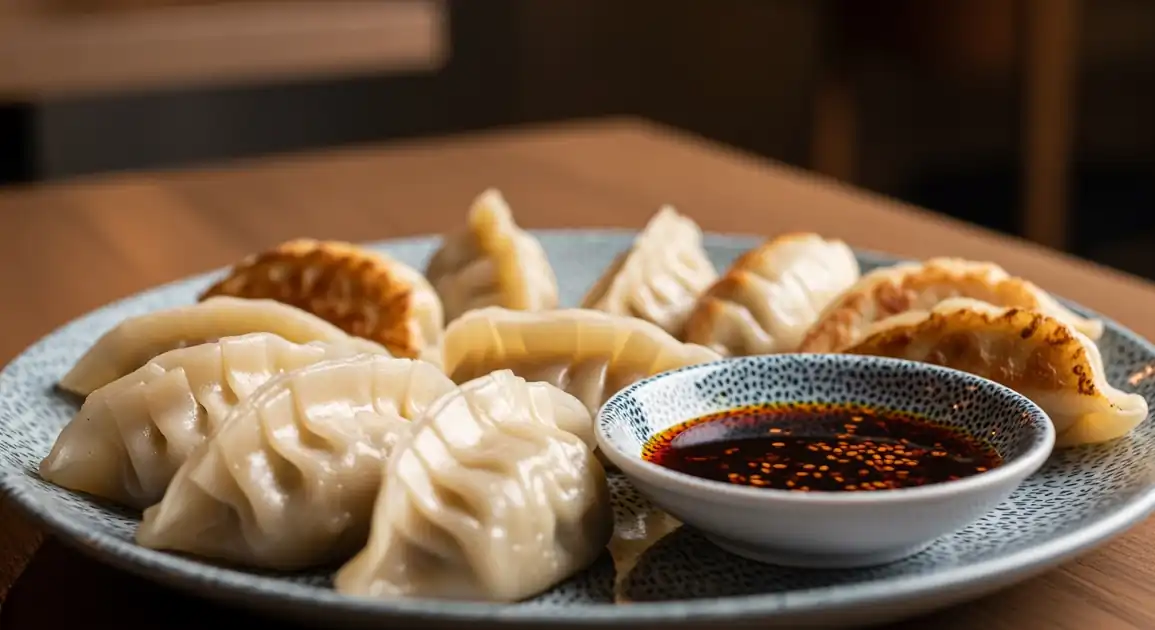Dumplings

Description
Dumplings are a culinary staple across Australia's major cities, deeply integrated into the dining landscape thanks to significant East Asian migration. While available everywhere, cities like Melbourne and Sydney boast particularly high concentrations of diverse and high-quality dumpling restaurants, ranging from traditional eateries to modern fusion spots.
Dietary Information
Serving information
Serving style
Served hot on plates or in bamboo steamer baskets. Eaten with chopsticks. Essential accompaniments are dipping sauces like soy sauce, black vinegar, and chili oil, often mixed by the diner at the table.
Quick facts
Restaurants: Generally 11 AM - 3 PM (Lunch), 5 PM - 10 PM (Dinner), some later. Food Courts: Align with shopping centre hours, typically 10 AM - 6 PM or later for late-night shopping.
Safety Tips
What to Look For
-
Dumplings cooked fresh to order or in frequent, hot batches
Ensures they are served at a safe temperature (above 60°C) and have the best texture. Avoid lukewarm batches.
-
Busy restaurant with high customer turnover
Indicates that ingredients are likely fresh and food doesn't sit around for long periods.
-
Clean premises: tables, floors, sauce containers, staff appearance
General cleanliness is a good indicator of overall food hygiene practices and reduces cross-contamination risk.
-
Clearly defined cooking areas (if visible)
Well-organized kitchens often correlate with better food handling procedures.
-
Dumplings appear plump and intact (not broken or deflated)
Well-formed dumplings suggest careful preparation and handling.
What to avoid
-
Pre-cooked dumplings sitting in lukewarm bain-maries or displays
These can be in the temperature danger zone (5°C - 60°C), allowing bacteria to multiply rapidly.
-
Dirty tables, sticky sauce bottles, unclean utensils
Poor front-of-house hygiene can reflect poor back-of-house practices.
-
Dumplings that look mushy, broken, or excessively greasy
May indicate overcooking, poor freezing/thawing, excessive oil use, or staleness.
-
Staff handling money and then food without washing hands or changing gloves
A clear sign of poor hygiene that significantly increases contamination risk.
-
Off-smells or fillings that taste sour or unusual
Trust your senses; if something seems off, do not eat it.
Price information
Price range
Budget tips
- Food court stalls generally offer lower prices per serving.
- Basic pork or vegetable jiaozi are often the most affordable options.
- Look for lunch specials at restaurants, especially on weekdays.
- Sharing several plates among a group can be cost-effective.
Value indicators
- A generous number of dumplings per serve (usually 8-15 pieces).
- Well-filled dumplings with quality ingredients.
- Properly cooked: steamed hot, pan-fried crispy, not oily.
- Complimentary tea often served in traditional establishments.
Where to Find This Dish
Chinatowns
The historical and often current heart of dumpling culture in cities like Melbourne and Sydney.
Melbourne Chinatown (Little Bourke St), Sydney Chinatown (Dixon St)
Lunch (12 PM - 3 PM), Dinner (5 PM - 10 PM)
University Precincts
Areas near universities often feature numerous budget-friendly and popular dumpling eateries.
Near University of Melbourne, Near University of Sydney, Near Monash University (Clayton)
Lunch (11 AM - 3 PM), Evening (5 PM - 9 PM)
Suburban Asian Hubs
Suburbs with large Asian populations often have excellent, authentic options (e.g., Box Hill in Melbourne, Chatswood in Sydney).
Box Hill Central (VIC), Chatswood CBD (NSW), Cabramatta (NSW)
Lunch (11 AM - 3 PM), Dinner (5 PM - 9 PM)
Shopping Centre Food Courts
Most major shopping centres house food courts with at least one Asian stall selling dumplings.
Westfield Centres, Emporium Melbourne, Chadstone Shopping Centre
During shopping hours (approx. 10 AM - 6 PM)
Vendor Tips
- Don't be deterred by basic decor; quality often lies within.
- Handmade dumplings, often visible being made, are usually superior.
- Ask staff for their specialty or most popular dish.
- Check if they accept card payments; some smaller places might be cash-only.
How to Order
Regional Variations
-
Xiao Long Bao (Soup Dumplings)
(Xiao Long Bao / 小笼包)
Delicate steamed dumplings originating from Shanghai, filled with minced pork and a savory hot broth that melts upon steaming. Eaten carefully with vinegar and ginger.
-
Pan-Fried Dumplings (Potstickers)
(Jiaozi / Guo Tie / Gyoza / Potstickers)
Crescent-shaped dumplings, typically filled with pork and chives/cabbage, chicken, or vegetables. Pan-fried until the bottom is crispy, then steamed.
-
Steamed Prawn Dumplings (Har Gow)
(Har Gow / 蝦餃)
A Cantonese Dim Sum favourite. Plump prawns encased in a chewy, translucent wrapper made from tapioca and wheat starch.
-
Steamed Pork & Prawn Dumplings (Siu Mai)
(Siu Mai / Shumai / 烧卖)
Another Dim Sum classic. Open-topped cylindrical dumplings usually filled with pork, prawn, and mushroom, often garnished with crab roe or a pea.
-
Wontons
(Wonton / 馄饨)
Thin-skinned dumplings, often with pork and prawn fillings, typically boiled and served in a light broth (Wonton Soup) or with a spicy Sichuan chili oil sauce.
-
Vegetarian Dumplings
(Vegetable Dumplings / 素饺子)
Filled with a mix of vegetables like cabbage, carrots, mushrooms, tofu, water chestnuts, and vermicelli. Available steamed or pan-fried.
Cultural context
History
The popularity of dumplings in Australia is closely tied to waves of Chinese immigration, starting from the 1850s gold rushes. Melbourne's Chinatown, established in the 1850s, played a crucial role. Initially niche, dumplings gained mainstream adoration in the late 20th and early 21st centuries, with dedicated 'dumpling houses' becoming ubiquitous and celebrated fixtures in major cities, reflecting Australia's embrace of multicultural cuisines.
Local significance
Dumplings represent a successful integration of multicultural cuisine into mainstream Australian dining. They are seen as affordable, versatile, social, and consistently satisfying.
Eating customs
- Using chopsticks is standard.
- Creating a personalized dipping sauce mix is common practice.
- Specific technique for Xiao Long Bao (spoon, nibble, sip, eat) is widely recognized.
- Often accompanied by Chinese tea.